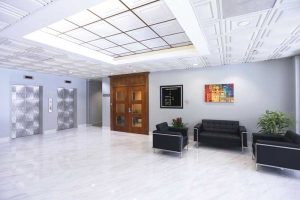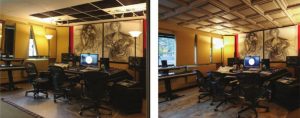
by Steven H. Miller, CDT, and Michael Chusid, RA, FCSI, CDT
The ceiling is the most visible surface in most rooms, the least obstructed of the horizontal and vertical bounding planes. Inevitably, aesthetics is one of the ceiling’s major functions. The most common type of suspended ceiling in non-residential buildings have a T-bar ceiling suspension system or grid with lay-in ceiling panels. Commercial-grades of these products tend to be durable in terms of serviceability, but the aesthetic function is prone to premature failure. To put it another way, many ceilings ugly out before they wear out.
The impetus for rejuvenation varies. The ceiling’s visual condition may simply have fallen below a level that is acceptable to the owner or occupant. Remodeling of other aspects of a space can raise the question, “What should we do about the ceiling?”
The COVID-19 pandemic is prompting other changes that may affect ceilings. Businesses are taking a fresh look at their premises to see if they are clean and hygienic. Property owners and their design consultants may have to remediate deficiencies in their buildings, remodel to accommodate changes in workflow or occupant spacing, or replace mechanical systems for improved ventilation—these changes can occasion a reconsideration of the ceiling’s condition, as well.
Rejuvenation-triggering problems can include a T-bar grid that is yellowed, stained, rusted, and, in more extreme circumstances, bent or damaged. Ceiling panels and tiles are even more vulnerable to discoloration and stains, and some types are prone to physical damage, as well. For example, absorbent panel materials that have been exposed to moisture can develop “water stains” that may actually be colonies of mold or bacteria.

Photos courtesy OC Recording Company
Can a ceiling be rejuvenated? Is it worth the cost? Or should it be removed and replaced with new materials? Answers to these questions depend on the degree of damage and the demands of the occupant.
On the grid
Of the two major components of a suspended ceiling—the T-bar grid versus the panels populating it—the former is usually more durable. In most instances, grid can be renewed by cleaning, repainting, or applying cover strips; replacement is only required if it has significant damage or the function of the ceiling has changed.
Before undertaking any substantive modifications to the ceiling, it is advisable to verify that the suspension system is adequate for the proposed work. For instance, when the authors looked above the suspended ceiling of an office they had rented, they discovered abandoned ductwork had been lowered and was dangerously resting on the grid. In another violation of safety requirements, heavy fluorescent troffers had not been secured independently to the structure above and were imposing load on the grid.
Grids are commonly made of light-gage steel, but may also be aluminum, plastic, or pultruded fiberglass. Assuming the suspension system was installed properly to begin with, it should provide years of serviceability under normal conditions. Heavy use, misuse, or abuse can induce sagging or misalignment of tees, or damage to the suspension wires supporting the grid. Suspension systems are particularly apt to be damaged during above-ceiling work, by impact from moving objects, and though improper use of the grid to support items beneath the ceiling.




